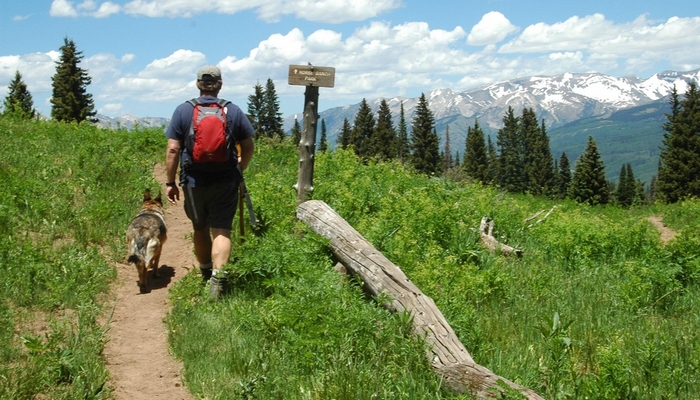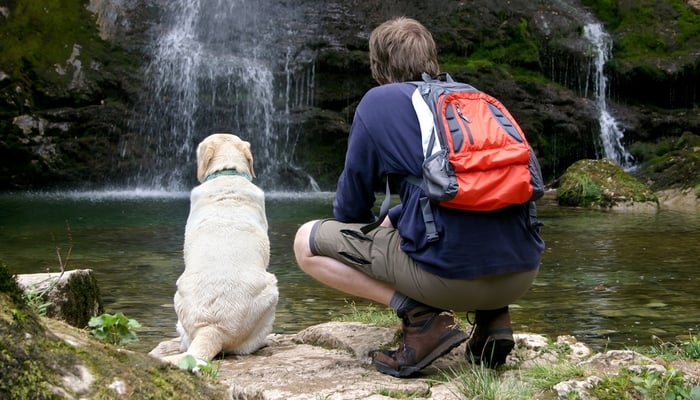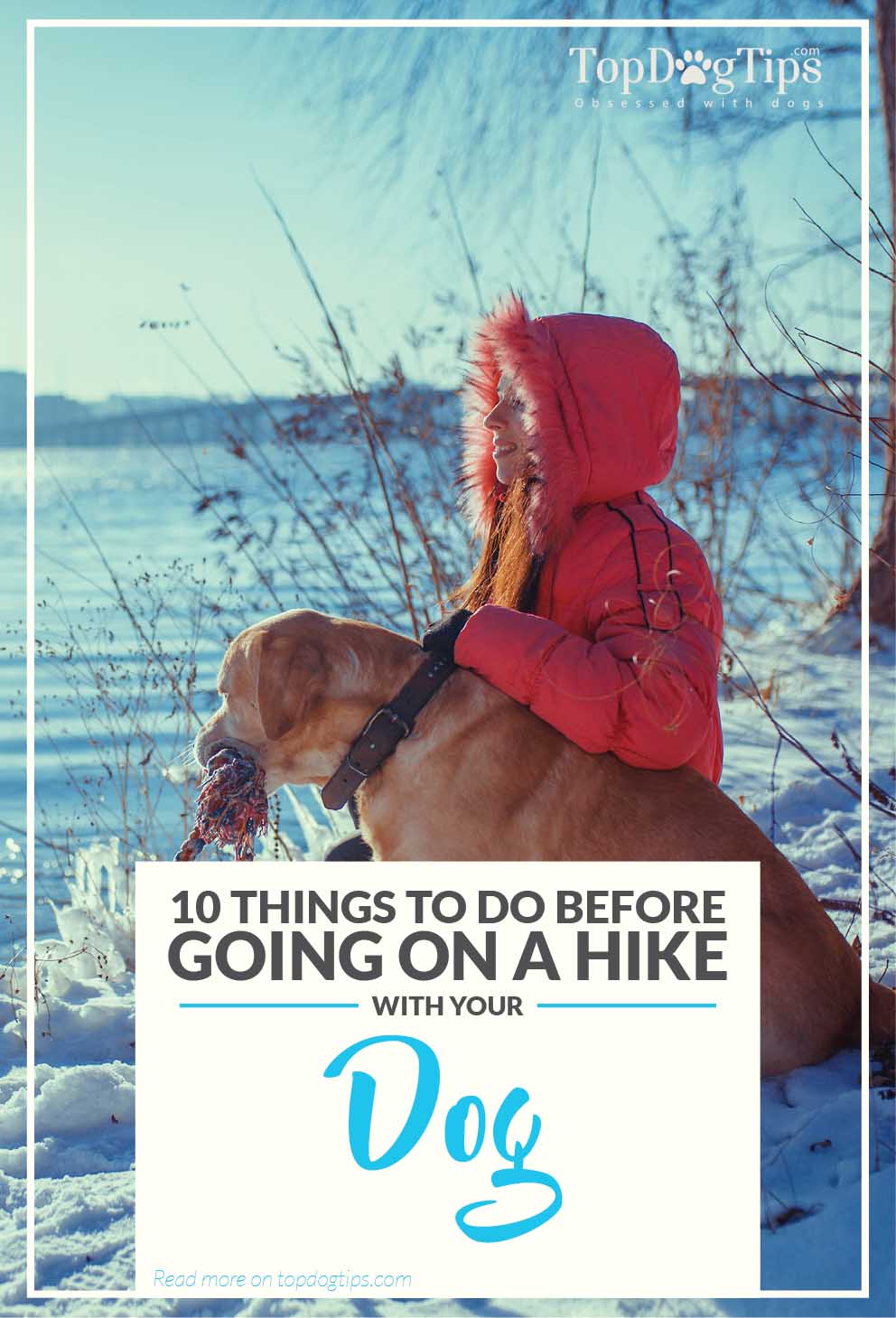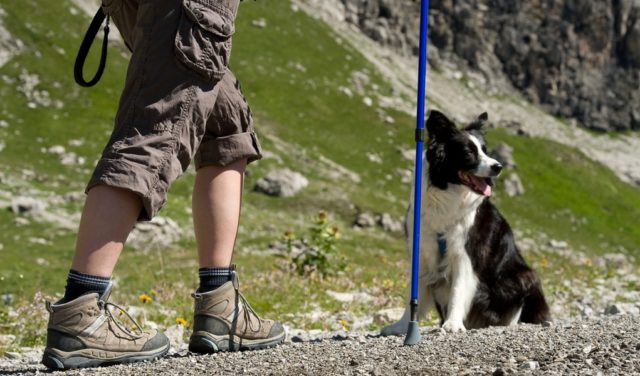
Table of Contents
If you’re an active person, then you love the exhilaration nature brings with it, and you enjoy hiking, camping, and other outdoor activities.
But have you considered taking your dog with you?
Dogs make good companions for a trek when they’re properly trained, and you have the right equipment for it.
As an avid hiker myself, I meet more and more people hiking with dogs on these trails.
Now and again, I will stop for a chat and quickly find that most of them aren't as prepared as they should be, even though they may think they are.
Most dog owners make basic mistakes like forgetting to carry enough water, food, and treats for the dog.
Others find themselves on the wrong side of the law since they don’t understand the basic rules regarding dogs on most public properties in the United States.
Finally, and most importantly, dog owners should keep a keen eye on their dogs when hiking to avoid losing their pets, which sometimes results in your dog attracting diseases or even dying, like what happened to this avid hiker.
This article is to serve as a guide on hiking with dogs to ensure your first (or any) trek with your canine is successful.
There are many things that you need to do before, during, and after going for a hike with your dog to keep him safe.
Be sure that you're properly prepared, or it could result in some serious consequences. This guide must be just the beginning of your research.
ALSO READ: 14 Safety Tips and Tricks for Hiking With Your Dog
Hiking with Dogs: Planning Your Hiking Trip
1 Rules and Etiquette of Hiking
First, make sure the trail you want to follow allows for dogs to come along.
Many parks in the U.S., for instance, have a no-dog policy.
Dogs are also required to be on the leash at most maintained public trails.
The majority require a leash to be 6 feet or less in length.
Never use an extensible dog leash. They aren’t optimal for keeping your dog in check.
Ensure you can keep your dog calm and collected when around other dogs and people.
Animal attacks aren’t taken lightly, and many dog breeds are known to be unpredictable.
Do research about the area you’ll be visiting.
It is the most important thing you can do to make sure you’re knowledgeable and prepared and don’t put yourself or the dog in danger.
2 Is Your Dog Physically Ready?
 All dogs are not the same. Some can handle heat better than others, while certain breeds are better designed to sustain longer and more challenging hiking trails.
All dogs are not the same. Some can handle heat better than others, while certain breeds are better designed to sustain longer and more challenging hiking trails.
Make sure your dog is ready for a good hike beforehand. Additionally, if you are going to equip your pet with his own dog backpack (also known as a saddle bag), then first get him used to it. Make your dog wear the backpack during short daily walks and later longer ones.
You should also take your canine on slightly longer walks relative to your usual daily “pee” walks.
This allows you to see how quickly your pet will get tired. Use this information to gauge how long you will need to go before taking a rest for his sake.
Sometimes, additional “training” before going hiking with dogs may be necessary.
Don't rush onto challenging hiking trails before your pet is ready, even though you may be.
3 First-aid Preparedness is Vital
I've been hiking for a long time, and I almost always take my dog with me.
When meeting other hikers on trails who love hiking with dogs, I noticed one pattern: nobody ever has any first-aid kits with them, neither for themselves nor the dog.
This is a big mistake.
Always ensure you carry a first-aid kit with at least the basic medical requirements, such as bandages and gauze for yourself and the dog.
Accidents happen on the trail, and it's unlikely you'll be close to a hospital, so make sure you are as prepared as possible.
RELATED: Step-by-Step Checklist for Going Hiking with Your Dog
Hiking with Dogs: Packing
4 Food and Water for Both of You
When hiking with dogs (or without them), hydration is perhaps the single most crucial aspect you have to keep in mind for both you and your pet.
You can either use crafty built-in hydration systems found in some packs or carry a collapsible bowl for food and water dishes.
One way to prevent dehydration in dogs is to mix some Pedialyte with your dog’s water.
Be sure to check with your vet to see how much is safe for your canine, as it will depend on his size and weight.
I personally make him carry a dog water bottle in the backpack.
However, depending on your dog's size, your pet should be able to carry his own food and water.
Usually, the average dog can carry up to 15% of their own body weight. Ensure you don’t overburden him, though, because this could lead to some serious spinal damage.
Before the trip, it's probably a good idea to feed your canine a little more food than usual, especially if it’s going to be a really long hiking trip.
Make sure you know what's best for your dog, or check with your vet so you don’t end up overfeeding him on poor stuff.
5 Drinking Safety and Dangers on Trails
If you're going on long hiking trails that may have water reservoirs around, it's bound to happen. Water intoxication is far more dangerous and common than many pet owners realize.
Your dog will be tempted to drink from anywhere and anything.
When hiking with dogs, always watch what and where your pet drinks.
Keep him away from it because there's been plenty of stories of people and animals dying of this.
Water in lakes and rivers may contain algae or parasites that will make your dog sick or cause death in some cases.
Once again, always keep plenty of fresh water at hand and train your dog to drink out of his bowl or a dog water bottle, never from unsafe sources.
If he does end up gulping down tons of water, since this is especially difficult to prevent if you’re going swimming or he loves to be in the water, ensure you take him to the vet afterward to have him checked.
Most parasites won’t manifest themselves for a while, but this doesn’t mean you are in the clear.
6 Additional Hiking Gear for Both
If you are paranoid (or extremely cautious) about having your dog out in the world, you could get some extra doggy hiking equipment to ensure you can always keep track of him in the event that you somehow get separated.
The list below also includes equipment for a more demanding trek that will last much longer than an afternoon walk in the park.
Being prepared is key when hiking with dogs.
Additional dog hiking gear that you may choose to bring along includes:
- Dog-specific pet bike trailer (for several day-long trails);
- Dog harnesses for more technical trails or climbing;
- Dog GPS collars and leashes that fasten to you via carabineers;
- Dog tent (most dogs really don’t like sleeping in tents, however);
- An optional consideration would be dog sunglasses;
- Good quality dog leashes that you can trust;
- Cooling collars or dog cooling vests for hot days and short trails;
- Saddle bag for your dog to carry his own equipment;
- Special dog boots for snowy, wet, and particularly rough terrain;
- Snacks and supplements to keep yourself and the dog energized.
Pro tip: I personally always use a hands-free dog leash that keeps my dog close by and doesn't tire my hands. It's a great idea, provided your dog isn't of a large breed, which would expose you to the risk of being dragged along a hill when he spots a squirrel. For more tips and ideas, check out the Dog Hiking Gear Guide.
7Sleeping Gear for Overnight Stays
 It's rare to go hiking with dogs and plan an overnight stay, nor would I recommend this (at least not for your first few trips). However, if you're dead set on it, be prepared.
It's rare to go hiking with dogs and plan an overnight stay, nor would I recommend this (at least not for your first few trips). However, if you're dead set on it, be prepared.
It depends on the weather. It’s probably not a good idea to go out in the rain, but if you can’t help it (you’re caught in a storm, for example), make sure to find shelter as soon as possible.
Dogs can also get hypothermia, just like humans, so it is better to play it safe.
There are plenty of different sleeping options that work well for you but not so for dogs.
Also, speaking from experience, dogs really hate sleeping in tents and would rather stay outside. They're usually not comfortable sleeping separately alone, either.
My best advice would be for you to carry an ultra-light 2-person bag so Fido can snuggle with you or next to you – this is especially a good idea if it's cold outside.
Small tents are also a good option.
8 The Essential Dog Clothing
In addition to the usual hiking with dog gear, dog clothing may sound over the top, but it will be pretty useful when you need it.
I've mentioned some of these as “extra” gear, but dog shoes and a dog life jacket really help to keep your dog safe from the elements.
Dog vests and coats are necessary in cold weather.
When it gets cold, your dog will likely refuse to walk or move really slowly and shiver silently beside you.
He could consequently fall ill pretty easily.
A warm dog coat will help him stay cozy and warm. Your dog may refuse to wear it at first but remember: if you're cold, then your dog is too.
On the other hand, if it's hot outside, then you can prepare for that, too.
Cooling vests are a good option; alternatively, you can soak a shirt in water and put it on your pooch for a while.
As the water evaporates, it will help to keep Fido cool. Cheap and easy to do.
 I can't stress enough the importance of dog boots. Shoes for dogs are an important piece of dog clothing that could reduce the risk of injury to his paws. Despite how ridiculous some of them may look, they were invented for a good reason.
I can't stress enough the importance of dog boots. Shoes for dogs are an important piece of dog clothing that could reduce the risk of injury to his paws. Despite how ridiculous some of them may look, they were invented for a good reason.
Most dogs, having lived in the city all their lives, have fragile paws and could easily get damaged by salt used to melt the snow or pricked by a jutting rock out on the trail.
Boots help to avoid such calamities and would keep him in prime condition.
Remember that the perfect size of dog shoes is important.
Watch the below video on how to put on boots for a dog, and make sure to pick the right size when shopping for them.
Finding the right size dog shoes may be tricky, and you’ll only realize this once they start falling off during a casual romp in the woods.
You'll also need to be sure that your dog is comfortable wearing pet boots before you try to take him hiking while wearing them.
GUIDE: How To Put Boots On A Dog
Hiking with Dogs: Fitting and Loading a Dog Pack
9 How Much Weight Can a Dog Carry?
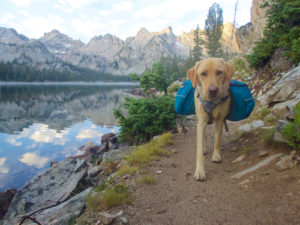 As I have mentioned above, your dog can carry his own load (and he should), saving you some effort.
As I have mentioned above, your dog can carry his own load (and he should), saving you some effort.
In general, most dogs can carry up to 25% of their weight.
Some breeds can carry from 10% to 15% more, while other breeds aren’t cut out to carry any weight at all.
The amount of load you should pack for your pet into his saddle bag also depends on his age.
Once again, it’s a good idea to discuss this topic with your vet before striking off for your adventurous hiking with dogs.
You should also consider a waterproof pack if there’s a chance it’s going to rain or snow.
The pack should preferably contain a place you can fix a light on. This really helps for night-time visibility, during morning treks, or through unexpected snow or fog.
There are even waterproof boots for dogs for the very same reason if you think you may need them.
10 How to Fit a Dog Backpack Properly
Once you have your dog saddlebag ready, it's important you know what you're going to put in there and how to “stuff” it properly.
Do not randomly pick out whatever items fit. Always weigh your dog's backpack to see if it's not going to be heavy for the dog.
In terms of fitting it onto your canine, there's a right way to do that as well:
1. The first step is to measure the circumference of your dog’s chest. Most dog packs are made in specific sizes, so you can find their corresponding measurement before buying one and avoid having to strap a bag that's too big or too small.
2. Place the middle of the dog pack (the weight should either be distributed on the sides or supported on the shoulders) on your dog’s back. Straps usually fasten around the waist, chest, and/or around the neck.
3. Adjust all straps to tighten the pack to fit your dog’s body snugly. Don’t pull too tight. Otherwise, he won’t be able to breathe. Be aware that a pack that is too loose can slip off. You need to tighten the straps until you can fit two fingers between the strap and your dog's body. Monitor the pack closely to make sure it's not too loose or too tight.
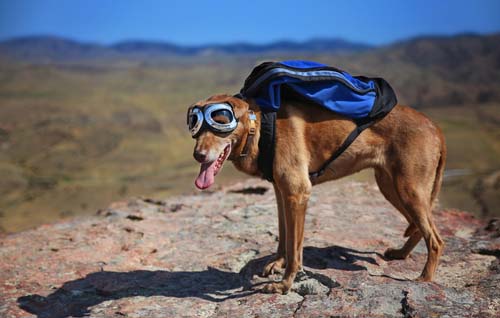
That is about it. Test the backpack on your daily walks with your dog to see how it works.
Post-Hiking Trip
You've done it – congratulations! What else is there to do afterward? A few things.
After your trip hiking with dogs, be sure to check your pet's body for parasites like ticks, burrs, and other suspicious foreign objects.
If you do find a tick, do not just pull it out manually by hand. There's a right and wrong way to do this.
There are different dangers of ticks for dogs; depending on the region you live, a vet will help you decide if you should remove the tick yourself or visit him at the office. Call her.
Also, make sure you bathe your dog thoroughly after you get home.
If his skin gets easily irritated or debris ends up stuck in his fur, a nice warm bath (done properly) will prevent irritation.
This will finalize your hiking trip, and you're now ready for the next!
READ NEXT: A Basic Guide to Hiking with Dogs


